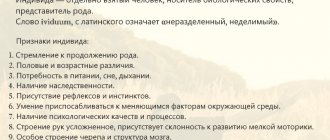In sociology, psychology and a number of other sciences, terms such as “person”, “personality”, “individual” and “individuality” are widely used. Many perceive them as synonyms, but each of these words has its own meaning and implies a specific set of characteristics. Therefore, these terms are not interchangeable and the context should be well understood when using them. Today we will analyze in detail how they differ from each other and how not to make mistakes when using these words in your own speech.
Definitions
- Man is a social being with consciousness and intelligence. This concept can have a biological or physical meaning. At the same time, it is the most generalized, so this word can designate both a very concrete person and an abstract one.
- An individual is a separate representative of the human race. This word denotes an individual unique person, abstracting from his morphological, psychological and social characteristics. It is obvious that an individual has a certain set of unique qualities, but within the framework of this concept they are insignificant.
- Individuality is a set of biological, psychological and social properties that make up the uniqueness of an individual, make him unique and distinguish him from other people. The components of individuality are temperament, character, intelligence, worldview, accumulated knowledge and life experience, morphological and other properties.
- Personality is a set of social qualities of an individual, which he one way or another realizes in his social life. This word can be used as a characteristic of an individual, or to designate a specific person in the context of studying his social characteristics.
Now let’s look at each of these concepts in more detail in order to more accurately understand how they differ, what they have in common, and in which cases which term should be used.
What characterizes a person as a person
The word “personality” itself had a negative connotation, since since ancient times it has meant a mask under which a person’s true face is hidden.
Typically, the word “mask” was used to characterize a person’s social image, and most often it was used as an insult.
But a lot of time has passed, and now the word “personality” is widely used both in everyday life of ordinary citizens and in educational literature.
Manifestations of personality can be both permanent and temporary: at one moment a person can show willpower, and in another situation he can simply remain silent.
Human
As we have already found out above, a person is a general concept that denotes a social being with consciousness and intelligence. Man was formed as a result of evolutionary development, as well as a number of socio-historical processes. Using this term, we usually mean a representative of the human race with all the qualities and characteristics inherent in the biological species Homo Sapiens (reasonable man).
From a psychological point of view, the term “human” combines biological and general social characteristics, as well as the ability to engage in various activities specific to a given biological species.
From a biological point of view, a person is a creature that differs from other mammals in such features as:
- upright posture and special body structure;
- using articulate speech to communicate;
- the presence of consciousness, the ability to understand the essence and cause of various phenomena;
- the ability to meaningfully and purposefully perform complex work in order to obtain a certain result (and not obeying instincts, as happens in animals);
- the ability to create and use tools.
From a philosophical point of view, a person is an integral system that has physical and mental principles, determined genetically. This is the unity of biological, social and spiritual qualities.
To remember how the concept of “person” differs from the concept of “personality”, you should understand one simple thing: a newborn child is already a person, since all the elements of human nature are inherent in him. At the same time, he becomes a person later - in the process of socialization, when he acquires his own individuality.
What is individuality?
All manifestations can be divided into three large groups. These are the features:
- External. These include the uniqueness of the anatomical structure, the chosen style, and the way of dressing. Having an individual style means having a subtle feel for the combinations of clothes, shoes, and jewelry. Make sure that the image corresponds to the internal content and reflects it.
- Behavioral. These include: habits, habits (including negative ones), gait, non-verbal verbal methods of communication. These are any actions that are expressed through behavior. They are completely controlled by the individual. Although sometimes subconsciously.
- Mental. These include the expression of emotions, as well as resentment, anger, and envy. Their positive individual traits are humor, resourcefulness, perseverance, and good memory.
Talent needs to be highlighted separately. This is what distinguishes us greatly and qualitatively from the majority. While many people have creative abilities, often acquired over several years, there are very few truly talented performers, actors, and artists. They can definitely call themselves an individual.
Ask a question
Individual (and individuality)
This term has a special meaning in such scientific disciplines as social science and law. An individual is a single and very specific representative of the human race. It is implied that each individual has a unique set of anthropological and psychological characteristics, but these are bracketed.
From the point of view of law, an individual is a subject of legal relations, a bearer of rights and obligations , considered as a legal abstraction. His appearance, character, life experience, health, personal qualities and other characteristics do not matter. A significant property is its legal capacity.
In social science, an individual means a person as a certain statistical unit of society, possessing a certain social status and position, engaged in some kind of activity. In essence, an individual is a “technical characteristic” of a person, a certain “identifier” that makes him unique. The child receives the status of “individual” immediately after birth (although this is a controversial issue, and many authors believe that the fetus in the womb can be considered an individual already in the second month of pregnancy, since by this time its nervous system is formed).
From the point of view of psychology, each individual has individuality - a special set of properties and characteristics that determine his uniqueness and originality. However, the concepts of “individual” and “individuality” should not be confused. An individual is a person, and individuality is his unique characteristic. It determines such characteristics as preferences, interests, behavior, etc.
Thus, a person is born an individual, but does not yet have individuality. It is formed as he grows up under the influence of the environment in which he grows and socializes.
In fact, the formation of individuality and personality occurs in parallel, but these concepts should not be confused either.
What does it mean to be an outstanding personality in social studies?
The term outstanding personality characterizes a person as strong-willed and strong, distinguished from everyone else.
The signs of such a person are obvious: willpower, determination in achieving their goals.
Most often, people perceive such a person as a standard: for example, Yuri Gagarin. After his flight, a huge number of Soviet boys wanted to become cosmonauts. This is the psychology of the crowd - the bulk always looks up to one person.
Of course, a person cannot be a bright and outstanding person without individuality: these concepts are interrelated and mutually compensate each other.
Personality
Personality is a concept used primarily in psychology. This is a subject with self-awareness, emotional experiences and the ability to know. Personality is formed exclusively in the process of socialization, and its basic properties are manifested in interaction with other individuals. From a psychological point of view, one of the key personality properties is the ability to play a certain role that meets the expectations of others.
The main characteristics of a personality are its potentials:
- creative – the ability to purposefully create material and intangible values;
- cognitive – the ability and desire to learn;
- communicative – the ability to interact with other individuals and develop through this interaction, while maintaining one’s own identity;
- value - a system of values, ideals, aspirations and beliefs acquired by an individual in the process of socialization;
- artistic – the level of artistic needs of the individual, manifested both in the creation and consumption of works of art.
The basis for personal development is considered to be her ability to control her life, make strong-willed decisions and act rationally, guided by logic and common sense, and not by immediate desires. A person who copes well with this is called a strong personality.
Obviously, a five-year-old child cannot be a strong personality. He still does not understand why and for what he should deny himself momentary pleasures. In addition, he has not yet developed responsibility, since he has no idea how serious the consequences of a seemingly harmless act can be.
It also happens that a fully grown person is not a mature person. He submits to desires and cannot subordinate them to his will. However, he is not necessarily such a rake. This may be a decent person with a good education and job, whose personality is still in the process of formation.
Personality formation is a very long process that includes 4 key elements:
- choice of social roles and related functions.
- awareness of the rules of behavior in force in society.
- relationship building and other social skills.
- the ability to make decisions and be responsible for their consequences.
A person who is a mature personality is easy to notice. As a rule, he is quite independent and does not worry about what people think about him , so he does not try very hard to meet the expectations of others.
But this does not prevent him from behaving with dignity. Thanks to this combination, others often choose such individuals as role models.
What is individual?
The main difference is the lack of specific, unique features. This is a person who belongs to the crowd, has similar characteristics, conforms to basic stereotypes and is susceptible to public opinion.
Such a person has not grown personally. At the everyday level, we can cite the following traits of an individual who never became a person:
- inability to make decisions;
- lack of responsibility for events;
- low social adaptability;
- following the opinion of the majority;
- lack of point of view;
- the ability to manipulate the person in question.
Differences between concepts
To summarize the above, let us list once again the main features and differences of the concepts under consideration. So, man is a general concept. Unlike the others, it can be used in a biological sense to refer to a member of the species Homo Sapiens. Moreover, in almost any context, the terms “personality” and “individual” can be replaced by the word “person”. But the statement will be more generalized.
An individual is a specific person. It is a technical or legal concept used in legal documents. It does not include any personal characteristics, but strictly indicates a specific person. From the point of view of law, an individual is a subject of legal relations (owner, heir, culprit of an accident). When we consider people as individuals, we consider them the same and neglect all their characteristics, except those that are important within the framework of the problem being solved.
A personality is a socialized person with character, temperament and worldview, actively interacting with other individuals. Personality does not arise on its own; it is formed through socialization that occurs in the process of growing up.
Individuality is a set of properties and qualities that make a person unique. It is formed in parallel with the personality. To better understand how personality differs from individuality, it is worth paying attention to what epithets these words are usually used with. About a person we can say that she is “strong”, “independent”, “independent”. Such epithets as “bright”, “memorable” or “unique” are more suitable for individuality.
Temperament types
Let's briefly look at each type of temperament and give it the corresponding characteristics.
Melancholic people
Of the 4 personality types, melancholic people are the “weakest”. They have weakly expressed inhibitory and excitatory processes, which makes them very sensitive.
Even something insignificant can cause melancholic people to worry. They are often depressed and more prone to depression. Among them you can often find neurasthenics who carefully hide their emotions.
For this reason, melancholic people may develop mental and nervous disorders, which in turn can cause diseases of the stomach, cardiovascular system, and liver.
Cholerics
Cholerics by nature are the complete opposite of melancholics. They are distinguished by an unbalanced and firm character.
An interesting fact is that people with this personality type are more likely than others to suffer from liver and gall bladder diseases. It is difficult for them to control their emotions, as a result of which they are characterized by irritability, outbursts of anger and often rage.
As a rule, choleric people have difficulty getting along with people. They are very impulsive, fussy and lively in conversations with their interlocutor.
Sanguines
Sanguine people are the most “lively” personality type. They are strong, balanced, active and often take the initiative. As a rule, sanguine people are inclined to work, as a result of which they are afraid of not being able to do something or making a mistake.
They are demanding not only of themselves, but also of others, which sometimes leads them to stress or depression.
People with this personality type most often suffer from diseases of the cardiovascular system. They are also susceptible to strokes and heart attacks.
Phlegmatic people
Phlegmatic people belong to the “calm” personality type. They are distinguished by prudence and balance. It is very difficult to piss them off.
This type of personality is not difficult to identify in a crowd of people: in the process of any unrest or general panic, they remain calm and try to stay away from the events taking place.
Phlegmatic people prefer not to get upset over trifles, trying not to take everything to heart. Despite this, they are the ones who suffer from stomach ulcers more often than other types.
Read more about temperament types here.
Interrelation of concepts
All of the above related mainly to the differences between the concepts under consideration. At the same time, there is a relationship between all of them, which also cannot be ignored. The concepts of “individual”, “individuality” and “personality” can be considered as stages of a person’s personal evolution. Every person becomes an individual immediately after birth. As he grows up, he acquires individuality , which consists of genetically determined and acquired properties.
Personality and individuality are formed in parallel, largely under the influence of the same factors. As an individual develops psychologically, he acquires unique traits that help him interact better with society and the environment. At the same time, all three concepts are applicable to it, which characterize it from different sides. Each person is an individual, personality and individuality. And what to call it depends on the goals and objectives set.
Classification of people by temperament
Few people know that the founder of the definition of personality types is the famous ancient Greek physician and philosopher Hippocrates. Being a leading doctor of his time, he conducted many interesting experiments.
Since Hippocrates was a supporter of materialism, he tried to find a connection between temperament and the amount of one of 4 fluids in the body: lymph, blood, yellow and black bile.
As a result, he introduced 4 main types of temperament:
- choleric;
- phlegmatic person;
- melancholic;
- sanguine
According to Hippocrates, yellow bile predominated in the body of choleric people, black bile - of melancholic people, lymph - of phlegmatic people, and blood - of sanguine people.
For obvious reasons, modern medicine cannot take seriously these conclusions of the famous ancient Greek doctor, who did not leave behind any explanation as to how he managed to identify such patterns.
An interesting fact is that Hippocrates compared a person’s character with his physical health. He believed that in our body thoughts, the state of organs and emotions are inextricably linked.
In modern medicine and psychology there is such a direction as psychosomatics. Psychosomatics (“psyche” - soul and “soma” - body) studies the influence of psychological factors on the occurrence and course of somatic (bodily) diseases. By approaching this issue correctly, many people have managed to get rid of various ailments associated with psychosomatics.
Relationship between terms
Based on the definitions of “individual”, “personality” and “person”, their characteristics in society can be represented as a set of certain qualities and traits . Despite significant differences, there is a strong connection between these concepts. At birth, everyone has a set of properties that can be developed and improved, thereby becoming an outstanding personality. And vice versa, if there is an unwillingness to become part of society, the subject degrades, and therefore does not become an individual.
Taken together, all three concepts can be combined with the word “subject”. It is understood as an actively cognizing the world, a purposefully acting individual. He is able to take initiative, be independent, make and implement significant decisions and bear responsibility for this. The inextricable connection between the three concepts is due to the fact that they all relate to a specific biological being.
Properties that characterize an individual
Each concept has its own special features that it possesses. The thing is that in psychology the term “individual” can be characterized by a number of properties. First of all, these are: gender, age category, body features, and characteristics of the functioning of brain activity. Secondly, other inclinations of a person, for example, the type of temperament, can be safely attributed to the properties of an individual. Age qualities can determine a number of characteristics of a person that identify him, the process of his formation as a result of ontogenesis.
Sexual characteristics are the distinctive features of gender. One can name a number of individual-typical parameters that are presented from the point of view of general somaticity, or as constitutional qualities that have neurodynamic distinctive features. Neurodynamic characteristics in this context should be considered as separate aspects of the human psyche.
How psychologists view this term
An individual is called the exact bearer of all the traits that are given to humanity. But in psychology, the term individual is characterized by the integrity of the psychophysical organizations of the body, its activity, as well as resistance to manifest actions.
A person lives as an individual from the beginning of his birth until the moment of death. This condition is the initial one on the planet from the point of view of its phylogenetic formation, as well as ontogenetic development. It is a concrete product of the creation of life, which actively interacts with a variety of surrounding criteria, and not a series of conditions that appeared suddenly. One thing is clear: it is impossible to consider a personality without close attention and emphasis on his individual characteristics.
They thus act as the foundation of human content. It is on them that a number of conditions for the development of each representative of the human race will depend, that is, on the inclinations that were invested in him at the genetic level. An individual has a number of basic functions, and specifically there are two of them. One is classified as conservation, thanks to which the process of distribution of energy and dynamic characteristics occurs, as well as a number of resource characteristics. But the other one is responsible for the function of so-called changes, from the point of view of plasticity of behavior.









